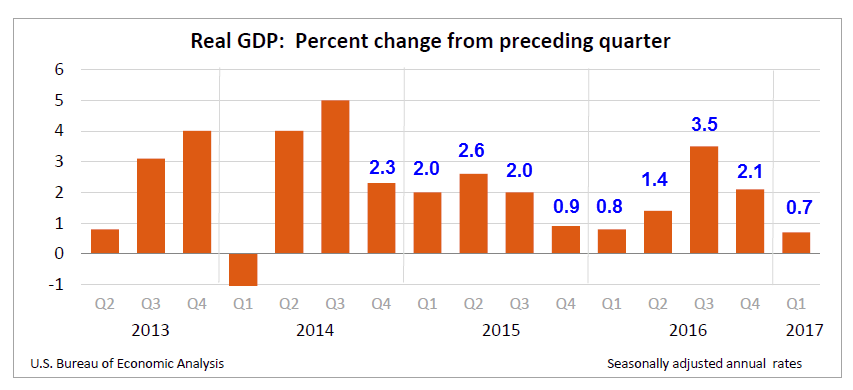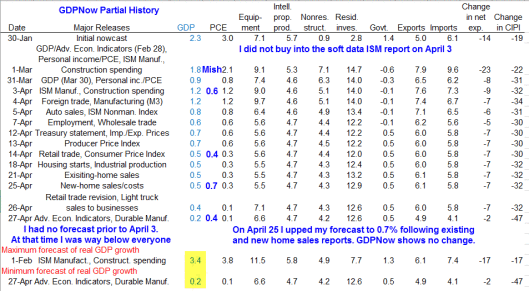First quarter real GDP came in at 0.7% vs an Econoday consensus estimate of 1.1%. Consumer spending was the weakest since the 4th quarter of 2009.
Highlights
The weakest showing since the last recession for consumer spending held down first-quarter GDP which could manage only a 0.7 percent rate of annualized growth. Consumer spending rose at only 0.3 percent which is by far the worst showing since no change in fourth-quarter 2009.
Weak vehicle sales are a major negative in the quarter’s consumer breakdown, pulling durables down at a 2.5 percent rate and offsetting a 1.5 percent rise in non-durables and a slow 0.4 percent showing for services.
Weakness in consumer spending is strongly associated with recession but not other data in the report. At a 13.7 percent pace, residential investment posted a second straight very strong quarter. And in a rare show of strength, nonresidential investment, which has been subdued, jumped at a 9.4 percent rate with both structures and equipment showing unusual strength. A surge in mining investment is a standout of the report.
The net export gap narrowed slightly which was a small plus for the quarter while a drop in government purchases was a negative. A sizable negative for the quarter was a slowing in inventory build, pulling GDP down by 0.9 percentage points but also keeping in check what may be unwanted stock given the weakness in consumer spending. Looking at final demand, which excludes the inventory effect, final sales rose 1.6 percent which is an improvement from the fourth quarter’s 1.1 percent.
This is a mixed report with the weakness in consumer spending not fitting with the strength in investment. Still, all the sky high confidence readings in the quarter did nothing to help actual spending. In other data, prices show pressure with the GDP price index at 2.3 percent for a 2 tenths gain and the core also at 2.3 percent for a 5 tenths gain.
BEA Release
Let’s tune into the BEA News Release for more details.
- The deceleration in real GDP in the first quarter reflected a deceleration in PCE and downturns in private inventory investment and in state and local government spending that were partly offset by an upturn in exports and accelerations in both nonresidential and residential fixed investment.
- Current-dollar personal income increased $161.9 billion in the first quarter, compared with an increase of $154.6 billion in the fourth. The acceleration in personal income primarily reflected an acceleration in government social benefits to persons that was partly offset by a downturn in personal dividend income.
- Disposable personal income increased $121.0 billion, or 3.4 percent, in the first quarter, compared with an increase of $141.6 billion, or 4.1 percent, in the fourth. Real disposable personal income increased 1.0 percent, compared with an increase of 2.0 percent.
- Personal saving was $814.2 billion in the first quarter, compared with $778.9 billion in the fourth. The personal saving rate — personal saving as a percentage of disposable personal income — was 5.7 percent in the first quarter, compared with 5.5 percent in the fourth.
Nowcast Model Needs Serious Work
The Federal Reserve Bank of New York needs to do some serious work on its model as I pointed out in advance. See Six GDP Estimates (Three Revised Today): ZeroHedge, Mish, GDPNow, Nowcast, ISM, Markit.
Model Flaws
- Nowcast uses no hard auto data: This is a serious error. Autos account for 20% of retail sales and fleet sales are also very important.
- Nowcast has an incorrect reliance on unemployment rate: People dropping out of the labor force and actual employment rising can both move the number in the same direction. Both things cannot mean the same thing.
- ISM vs PMI: Both reports measure the same thing, yet those reports signal very different things. At least one of them is wrong. GDPNow and Nowcast both rely on ISM even though the PMI reports have been more accurate, at least recently.
- The GDPNow and Nowcast models both suffer from an inability to think. The weather provides a nice example. In December, the weather was unusually cold, causing Industrial Production numbers to soar (heat and electric production), for the entire upcoming quarter. I estimated in advance, January would take away those numbers. My assertion played out, at least for GDPNow. I still cannot account for Nowcast.
Mish Estimate History
- On April 3, on Coast-to-Coast, live syndicated talk radio, I told George Noory I expected GDP would be 0.6%.
- On April 14, I lowered my forecast to 0.4% following retail sales reports as noted in GDP Forecasts Dip Again
- On April 25, following the existing and new home sales reports I up my forecast to 0.7%.
- On April 27, following inventory and durable goods reports I lowered my forecast back down to 0.4%
GDPNow Partial History vs Mish
GDP Predictions
- GDPNow April 27: 0.2%
- Mish April 27: 0.4%
- ZeroHedge April 27: 0.4%
- Markit April 21: 1.7%
- FRBNY Nowcast April 21: 2.7%
- ISM April 3: 4.3%
The FRBNY Nowcast was heavily influenced by soft data including the ISM reports. The other major error was a complete omission of hard auto data.
This material is based upon information that Sitka Pacific Capital Management considers reliable and endeavors to keep current, Sitka Pacific Capital Management does not assure that this material is accurate, current or complete, and it should not be relied upon as such.
Recommended Content
Editors’ Picks
EUR/USD alternates gains with losses near 1.0720 post-US PCE

The bullish tone in the Greenback motivates EUR/USD to maintain its daily range in the low 1.070s in the wake of firmer-than-estimated US inflation data measured by the PCE.
GBP/USD clings to gains just above 1.2500 on US PCE

GBP/USD keeps its uptrend unchanged and navigates the area beyond 1.2500 the figure amidst slight gains in the US Dollar following the release of US inflation tracked by the PCE.
Gold keeps its daily gains near $2,350 following US inflation

Gold prices maintain their constructive bias around $2,350 after US inflation data gauged by the PCE surpassed consensus in March and US yields trade with slight losses following recent peaks.
Bitcoin Weekly Forecast: BTC’s next breakout could propel it to $80,000 Premium

Bitcoin’s recent price consolidation could be nearing its end as technical indicators and on-chain metrics suggest a potential upward breakout. However, this move would not be straightforward and could punish impatient investors.
Week ahead – Hawkish risk as Fed and NFP on tap, Eurozone data eyed too

Fed meets on Wednesday as US inflation stays elevated. Will Friday’s jobs report bring relief or more angst for the markets? Eurozone flash GDP and CPI numbers in focus for the Euro.

